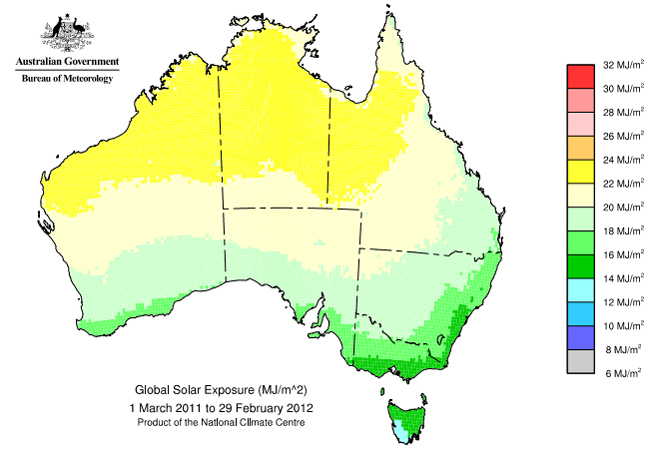Australia sees a great deal of the sun - more so than many other countries. For that reason it's a great place to tap directly into the energy contained in the sunlight. Australia is a big place though, and as anyone from Melbourne or Hobart can tell you, sun exposure is by no means a guarantee. Different areas of Australia will see varying amounts of sun, and for that reason will get varying amounts of success with solar.

Image source: Australian Bureau of Meteorology
What is insolation?
Insolation is a term given to the measurement of solar energy that can be collected in a given area over a given time, usually measured in square metres and hours. The insolation value for different areas of Australia will be greater in the hotter northern climates such as those in Queensland and the Northern Territory. Houses in southern states like Victoria and Tasmania are likely to achieve lower insolation values.
Because of these lower insolation values (i.e. amount of sunshine), solar photovoltaic systems in the southern states need to be larger to achieve the same amount of energy output as those in the north. In overall terms, Australia receives on average 4-6 kilowatt hours (kWh) per square metre per day during the winter, with values exceeding these achieved to varying degrees in the summer months.
How weather affects solar power installations
Inclement weather with heavy cloud cover will reduce the amount of energy your system can collect. The clouds diffuse the light, bouncing it in many directions, and can reduce efficiency by 50% or more. There's little that can be done to prevent this - weather will do what it will. Having said that, your panels will always absorb some of the ambient light during the day, so your system will never stop producing energy entirely until the sun goes down fully.
Rain and (in extreme cases) snow can sit on your panels briefly, but if the panels are angled properly will mostly slide right off the tempered glass surface, and will not cause any obstruction. The most danger an average PV system will face will come in the form of a hailstorm, where larger hailstones can damage the glass.
On the other end of the scale, extremely dusty conditions can reduce the amount of light that gets through and unlike rain, won’t slide so readily off the surface of your panels. Keeping them free of dust through regular cleaning will help though.





